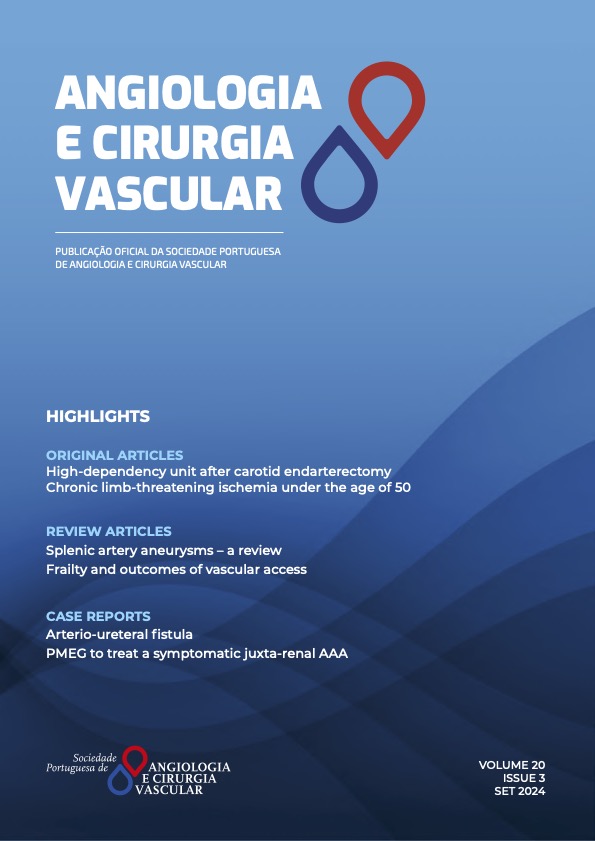Chronic limb-threatening ischemia under the age of 50 – a single-center 12-year retrospective study
DOI:
https://doi.org/10.48750/acv.621Keywords:
Premature peripheral artery disease, premature chronic limb-threatening ischemia, endovascular, open revascularisationAbstract
INTRODUCTION: Premature peripheral artery disease (PAD), defined as occurring before or at the age of 50, is a poorly studied subset of PAD due to its low incidence. It has been associated with a higher risk of progression to chronic limb-threatening ischemia (CLTI), major adverse limb events and mortality. Etiology is multifactorial, with genetics and environmental causes at play, with the most common risk factors being smoking, diabetes, and hypertension.METHODS: A single-center retrospective study was conducted in a Portuguese tertiary center, including all patients up to the age of 50 submitted to a revascularization procedure for CLTI from May 2011 to November 2023. The primary endpoint was a composite outcome of mortality, amputation and/or reintervention. The secondary endpoints were reintervention, amputation and mortality rates, and amputation-free survival (AFS).
RESULTS: Ninety-one patients were included (74% male, median age 48). The most common risk factors were smoking (69%), diabetes (45%) and hypertension (44%). Most patients presented as Fontaine grade IV (79%). Thirty-two patients (35%) had aortoiliac lesions, while 38 (42%) had femoropopliteal, and 21 (23%) had infra-popliteal disease. During the median follow-up period of 7.4 years (IQR 4.3-10.3), 57 patients (63%) underwent reintervention, amputation, or died. The reintervention rate was 40%, while amputation was performed on 25% of patients, and 29% of patients died. Median AFS was 4.7 years (IQR 0.8-7.8). Subgroup analysis comparing diabetic and non-diabetic patients and endovascular vs. open surgery were performed. The 30-day amputation rate was significantly higher in diabetics (12% vs. 2%, p=.05), but there were no other significant differences in subgroup analysis.
CONCLUSION: Premature CTLI is associated with poor outcomes and high mortality rates, with most patients undergoing reintervention or amputation. Further studies are needed to identify non-traditional risk factors to improve outcomes in this young population.
Downloads
References
– Mehta A, Dhindsa DS, Hooda A, Nayak A, Massad CS, Rao B, et al. Premature atherosclerotic peripheral artery disease: An underrecognized and undertreated disorder with a rising global prevalence. Trends in Cardiovascular Medicine. 2021 Aug;31(6):351–8
– Lane JS, Vittinghoff E, Lane KT, Hiramoto JS, Messina LM. Risk factors for premature peripheral vascular disease: Results for the National Health and Nutritional Survey, 1999-2002. Journal of Vascular Surgery. 2006 Aug;44(2):319–25
– Barretto S, Ballman KV, Rooke TW, Kullo IJ. Early-onset peripheral arterial occlusive disease: Clinical features and determinants of disease severity and location. Vascular Medicine. 2003 May;8(2):95–100
– Kim TI, Aboian E, Fischer U, Zhang Y, Guzman RJ, Ochoa Chaar CI. Lower extremity revascularization for CLTI among patients at the extremes of age. Annals of Vascular Surgery. 2021 Apr;72:517–28
– Kim TI, Loh S, DeWan A, Murray M, Mojibian H, Mani A, et al. Major adverse limb events among patients with premature peripheral artery disease compared with those at the common age undergoing revascularization in the vascular quality initiative. Annals of Vascular Surgery. 2022 Nov;87:188–97
– Rana H, Andrews JS, Chacko BG, Hansen KJ, Levy PJ. Mortality in patients with premature lower extremity atherosclerosis. Journal of Vascular Surgery. 2013 Jan;57(1):28–36
– Bérard AM, Bedel A, Le Trequesser R, Freyburger G, Nurden A, Colomer S, et al. Novel risk factors for premature peripheral arterial occlusive disease in non-diabetic patients: A case-control study. PLoS ONE. 2013 Mar 22;8(3)
– Madigan MC, Farber A, Rybin DV, Doros G, Robinson WP, Siracuse JJ, et al. Younger patients have worse outcomes after peripheral endovascular interventions for suprainguinal arterial occlusive disease. Journal of Vascular Surgery. 2021 May;73(5):1715–22
– Valentine RJ, Jackson MR, Modrall JG, McIntyre KE, Clagett GP. The progressive nature of peripheral arterial disease in young adults: A prospective analysis of white men referred to a Vascular Surgery Service. Journal of Vascular Surgery. 1999 Sept;30(3):436–45
– Valentine RJ, Grayburn PA, Eichhorn EJ, Myers SI, Clagett GP. Coronary artery disease is highly prevalent among patients with premature peripheral vascular disease. Journal of Vascular Surgery. 1994 Apr;19(4):668–74
– Chaar CI, Makaroun MS, Marone LK, Rhee RY, Al-Khoury G, Cho JS, et al. Impact of endovascular options on lower extremity revascularization in young patients. Journal of Vascular Surgery. 2012 Sept;56(3)









